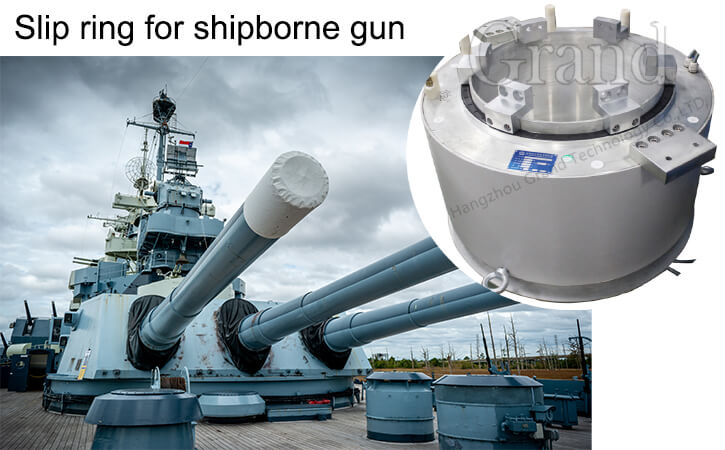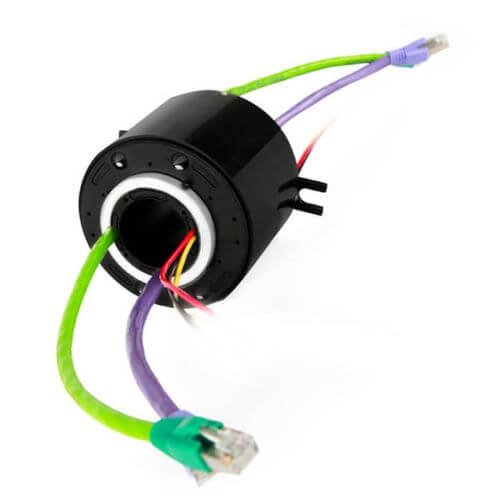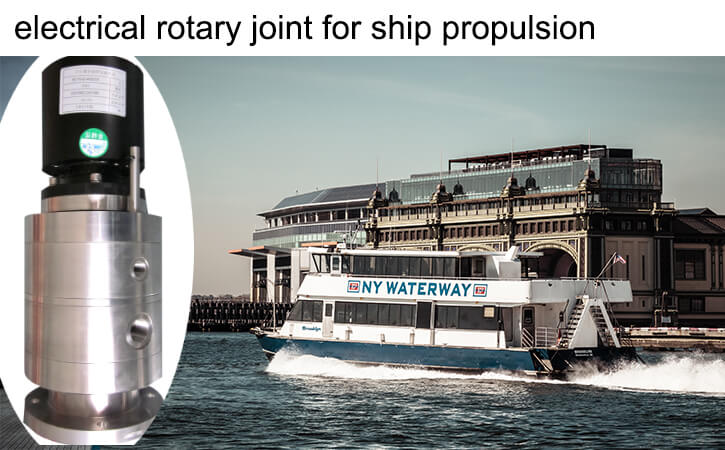In the intricate world of naval technology, every piece of machinery plays a decisive role in ensuring seamless operations. One such piece of machinery is the humble slip ring, an electromechanical device that facilitates the transmission of power and signals from a stationary interface to a continuously rotating one. This seemingly straightforward function of slip rings holds pivotal importance in the operation of marine vessels, particularly naval ships.
Slip rings employed on naval ships enable an uninterrupted flow of electrical power and signals in the vessel’s myriad systems, ensuring that these systems function smoothly even as they rotate during operation. Systems such as radar antennas, turrets, missile launchers, and other high-tech communication equipment are heavily dependent on slip rings. These devices combat the inherent obstacles of continual rotation without affecting performance or causing intervention in signal transmission, dramatically improving the operational efficiency of the ship.
In this article, our focus goes beyond the basic understanding of slip rings. We delve into the depth of their functionality and examine their fundamental role and applications on naval ships. We will explore the various types of slip rings utilized in naval operations, addressing common concerns, investigating case studies, and envisaging future trends in slip ring technology.
By uncovering the unique role and concerns surrounding slip ring applications on naval ships, our aim is to engage and enlighten the readers on the vital yet underrated role of the slip ring in fortifying the operational capabilities of naval ships. So, whether you are at the helm of managing naval operations, a stakeholder in marine technology, or someone with a keen interest in naval technology, this article is geared to provide meaningful insights into the crucial role of slip rings in naval ship applications.
Therefore, take this opportunity to explore how this compact, seemingly unassuming yet complex piece of technology, the slip ring, plays an unparalleled role in strengthening the backbone of naval operations. This exploration promises to enhance our mutual appreciation of naval technology’s sophistication and the relentless work that goes into ensuring their flawless execution and relentless efficiency.
Understanding of Slip Rings in Naval Context
Navigating the sector of naval technology requires a sound understanding of the dynamic machinery and equipment involved. One such piece of equipment, which is vital yet seldom brought into the limelight, is the slip ring. In the maritime context, specifically relating to naval ships, slip rings are not merely generic; they are specially customized to meet the rigorous service conditions of the marine environment while serving the diverse needs of the ship’s systems.
To comprehend the role of slip rings in naval ships, we must first look at their core function. Simply put, slip rings provide a continuous electrical connection between the stationary and rotating parts of the ship’s machinery. Amid the process, they carry a variety of futuristic signaling protocols that help in the transmission of power, data, and signals, while ensuring uninterrupted rotation.
Notably, the slip ring’s role is not confined to the single act of transmission. Specialized naval slip rings also have the demanding task of withstanding harsh naval conditions—such as high humidity, salinity, and extreme temperatures—without compromising performance or service life. Hence, they are typically built with robust materials, and often encapsulated, to resist corrosion and maintain outstanding insulation levels.
Complementing the varying operational requirements, different types of slip rings are employed aboard naval vessels. For instance, capsule slip rings—compact and cost-effective—are usually integrated into small and medium-sized systems, where space conservation is essential. High-power slip rings, on the other hand, are ideal for large-scale and power-intensive applications, including propulsion and turret systems.
Another popular type is the Ethernet slip ring, designed for the transmission of high-speed data, which is crucial in the information-rich environments of today’s naval ships. With advancements in naval communication technology, Fiber Optic Rotary Joints (FORJs), which allow the transfer of optical signals, are increasingly being integrated with electrical slip rings to meet the demand for high bandwidth data transmission.
Through this comprehensive look at the function and diversity of slip rings, it becomes evident that they are not merely an accessory but an integral component of naval ship mechanisms. With specific reference to their type, make, and application, they are carefully selected to meet the demanding requirements and rigors of naval service conditions, underlining their crucial role in this context.

Application of Slip Rings in Naval Systems
The range of technologies deployed on modern naval ships is immense, with each piece of machinery playing a pivotal role in operations. Among these technologies, one consistently contributes to the smooth interoperability of different systems—slip rings. Their function may seem straightforward, but the range of applications they support and the challenges they encounter within a naval environment convey their remarkable versatility and importance.
Slip rings are employed extensively across a multitude of operational areas aboard naval vessels. Complex radar systems rely heavily on slip rings, relying on their ability to manage electrical noise and ensure seamless data transmission. Meanwhile, rotating weapon platforms like turrets and missile systems require slip rings for efficient power supply and signal transfers, enabling accurate control and functionality.
Commendably, slip rings also find crucial use in sonar arrays, optical rotary joints, and even remote-operated underwater vehicles. Essential communication equipment—ranging from antennas to satellite dishes—relies on slip rings for continuous rotation without interrupting signal transmission. Thus, their applications in naval systems are vast and varied, underlining their undisputed versatility.
Given the exposure to the challenging naval environment, slip rings’ design and use are shaped by the need to withstand potential hurdles often thrown by such conditions. Naval slip rings are therefore designed with extreme robustness to resist the corrosive nature of seawater, the mechanical wear and tear caused by vibrations, shocks, and continuous rotation while ensuring optimal performance under temperature extremes. All these conditions have informed their design, yielding encapsulated, sealed or surface-plated slip rings to ensure reliability and longevity.
Moreover, the increasing complexity of systems deployed on naval vessels and the growing demand for high-volume data transmission influenced the design and evolution of more sophisticated slip rings, like Ethernet slip rings and Fiber Optic Rotary Joints (FORJs). These designs have been pivotal in addressing the need for faster data transmission speeds without sacrificing signal integrity.
In summary, the ubiquity of slip rings in various naval systems is evident. They are not only instrumental in diverse operational areas but also brilliantly adapt to the particular challenges of the naval environment. The design and evolution of slip rings have truly been shaped by their unique demands and requirements, underscoring their inextricable link to the success of naval operations.
User Concerns and Solutions in Naval Ship Slip Ring Applications
In the complex environment of naval operations, the utilization of slip rings is often met with a variety of practical concerns. Seamlessly addressing these concerns can greatly impact the operational efficiency of the ship, leading to fewer disruptions and downtime. Key concerns typically include reliability, maintainability, resilience to maritime environmental factors, and cost-effectiveness.
Reliability tops the list, as the unpredictable nature of the naval environment coupled with critical operation systems calls for highly dependable slip rings. A single fault in the slip ring can disrupt critical systems such as radar, navigation, or weapon systems and could significantly compromise the ship’s mission. Therefore, users demand slip rings with high reliability—able to perform consistently under different conditions, with minimal risk of failure.
Maintainability is another vital concern. Given the complexity and interconnectivity of systems in naval ships, simplicity in maintenance is preferred, reducing the time, expertise, and cost required for repairs or replacements. Slip rings with modular designs, for instance, can allow for easier servicing and replacing of parts without having to dismantle entire machinery.
Environmental resilience is essential due to the maritime environment’s harsh factors—seawater corrosion, extreme temperatures, and continuous vibrations and shocks. Users naturally favor slip rings featuring protective measures against these factors, such as corrosion-resistant coatings, temperature-tolerant materials, and robust build for mechanical resilience.
Lastly, cost-effectiveness is a universal concern for users. While high-quality, resilient slip rings may come with a higher initial cost, users focus on long-term cost-effectiveness, considering durability, maintenance costs, and the potential cost of system disruptions due to slip ring failures.
Industry solutions to these user concerns are innovative and varied. Manufacturers have introduced slip rings with advanced materials and designs to enhance reliability, such as gold-on-gold contact technology to ensure long-lasting, reliable electrical contact. For maintainability, modular designs allow for the replacement of problematic parts without requiring the total replacement of the slip ring. Slip rings made from corrosion-resistant materials or provided with specialized coatings have become standard to effectively contend with the salty sea environment. Additionally, cost-effectiveness is achieved by developing slip rings that can withstand rigorous conditions for extended periods, minimizing total lifecycle costs.
Real-world data is evidence of the efficacy of these measures. For instance, reports indicate that advanced slip rings have significantly reduced system failures and downtime, boosting the reliability of critical naval systems. Similarly, advancements in the modular technology of slip rings have positively impacted maintenance times and costs.
In summary, while user concerns in naval slip ring applications are plausible and understandable, the industry’s response in addressing these concerns is equally commendable. The practical solutions provided have been reinforced by real-life data, allowing users to have increased confidence in the application of slip rings on naval ships.
Impact and Importance of Slip Rings in Naval Ships
In the intricate world of naval operations, equipment that might be perceived as small or inconspicuous often drives the most significant impact. Among these invisible powerhouse components are slip rings, whose influence on naval ship functionalities is profound. Their role is integral, extending from the smooth functioning of individual systems to the overall efficiency and reliability of the naval ships as a whole.
Slip rings markedly elevate certain functionalities and systems aboard a naval ship. Consider, for instance, radar and communication systems that depend heavily on slip rings for continuous, jitter-free data transmission even when rotating. In the absence of slip rings, these systems would simply fail to rotate, or suffer high attenuation losses in signals.

Similarly, pivotal weapon systems like turrets and missile launchers also exploit the versatility of slip rings for seamless power supply and control signal transmission even while in operation. Without the slip ring’s ability to handle multiple channels of signals, such pivotal equipment might lack the necessary operational fluidity.
Even in specialized marine applications, like sonar arrays and remotely operated vehicles (ROVs), slip rings play a critical role—in ensuring smooth power, data, and signal transmission. This is crucial in preserving the intricate balance of power and control required in these systems.

When we examine the impact of slip rings at an operational level, it is not an exaggeration to state that they often hold the key to the overall efficiency and reliability of a naval ship. A failure in even a single slip ring can lead to critical system failures, like disruptions in radar or communication systems, which could impede the ship’s abilities.
Moreover, the sophistication of modern slip rings—including Ethernet slip rings and FORJ—facilitates the transfer of high-speed data. This not only elevates the quality and speed of data-dependent naval functionalities but contributes to the increased efficiency of information-centric naval operations.

Therefore, it’s clear that while slip rings might appear as a standard technical accessory in the maritime context, their importance is grossly understated. By improving the functionalities of various systems and bolstering the overall efficiency and reliability, slip rings can quite aptly be deemed as the unsung heroes of naval operations.
Case Studies of Slip Ring Applications in Naval Ships
The theoretical understanding of slip ring utility in naval ships can be enriched by looking at actual case studies where they have been effectively integrated into these maritime platforms. These case studies underscore not only the practical utility of slip rings in naval ships but also the demonstrable outcomes that arise from their inclusion.
Case Study 1: Radar Systems on a Naval Destroyer
In a particular application on a modern naval destroyer, the ship’s multi-function radar system required a slip ring for efficient transmission of power and high-quality data between rotating and stationary parts. A slip ring with gold-on-gold contact technology was implemented due to its high reliability and low electrical noise. Following integration, the ship’s radar system could operate continuously, enabling 360-degree coverage for situational awareness and threat assessment. This improved the overall defense operations of the destroyer and affirmed the significant role of the slip ring in such a critical maritime application.
Case Study 2: Communication Antenna Systems on a Frigate
Another compelling example comes from a frigate that had a sophisticated communication antenna system. A robust Ethernet slip ring was incorporated to facilitate unimpacted rotation and high-speed data communications. Following the integration of the slip ring, the frigate experienced streamlined and enhanced data transmission speeds, contributing greatly to the efficiency of the ship’s communication operations. It also minimized potential data losses during rotation, further boosting the operational efficiency of the frigate.
Case Study 3: Turret System on a Battleship
A case where high-power slip rings were used in a naval battleship turret system showcased their effectiveness in handling power-intense naval applications. The unique design of the slip ring ensured continuous rotation and power transfer for the heavy turret system. The integration improved the mobility and response speed of the turret, enabling rapid adjustments and increasing the ship’s defensive and offensive capabilities.
Through these case studies, the practical utility and tangible outcomes of slip ring integration become evident. Their role goes beyond enabling continuous electrical connectivity; they contribute directly to the overall performance and efficiency of naval ships. Therefore, these instances highlight the versatility, reliability, and functionality of slip rings, underscoring their critical importance in naval applications.
Future Trends and Developments in Naval Ship Slip Ring Applications
In the constantly evolving landscape of naval technology, it’s fascinating to predict the trajectory of slip ring technology. Given their inherent indispensability and the advancements in the field, application, and development trends in naval ships are expected to reflect adaptation to newer challenges and an enhanced role.
One of the expected trends is the development of more specialized slip rings to cater to specific naval applications. With the increasing lean towards customized and advanced naval systems, we foresee the emergence of application-specific slip rings that can cater more efficiently to system demands.
Toward the goal of higher-speed data transmission, the use of Fiber Optic Rotary Joints (FORJs) may rise exponentially due to their ability to accommodate substantial data bandwidths without signal interference. Ethernet slip rings may evolve even further, potentially incorporating advancements in technology such as Power over Ethernet (PoE).
Given the increasing consciousness about climate change and environmentally friendly engineering, the focus on building resource-efficient, sustainable, or low-emission slip rings may intensify. We may see the development of slip rings that are manufactured from recycled or environmentally friendly materials or designs that effectively minimize energy losses.
Additionally, with the growth of naval automation and the Internet of Things (IoT), more intelligent slip rings with integrated sensors and diagnostic capabilities might become more prominent. By constantly monitoring their own functioning and health, these smart slip rings could significantly enhance maintenance predictability and reliability, thereby reducing unexpected downtime.
As for the anticipated improvements in naval operations attributed to these developments, the impact is likely to be manifold. High-speed data transmission will enhance the efficacy of radar, communication, weapon, and control systems. Environmental adaptations will conform to new regulations and societal expectations about naval operations’ environmental impact. Meanwhile, the introduction of smart slip rings will empower preventative maintenance practices, reinforcing the reliability and efficiency of operational frameworks.
In conclusion, the future of slip ring applications in naval ships appears to be ripe with exciting possibilities. They are expected to adapt and morph along with the expectations and advancements in naval technology, reinforcing their integral nature in naval operations.
Conclusion
In conclusion, the application of slip rings in naval ships, though not conventionally glamorous, remains a crucial component of naval machinery. From facilitating the efficiency of radar systems to ensuring precise control of weapon systems, slip rings truly leave an indelible mark on the operational capabilities of naval ships. As technology continues to evolve and naval operations grow more complex, the role and importance of slip rings will only become more pronounced, reinforcing their indispensable character.
See What We Can Do

